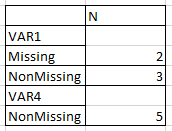- Home
- /
- Programming
- /
- SAS Procedures
- /
- Good Tabulate method for Character Missing Values
- RSS Feed
- Mark Topic as New
- Mark Topic as Read
- Float this Topic for Current User
- Bookmark
- Subscribe
- Mute
- Printer Friendly Page
- Mark as New
- Bookmark
- Subscribe
- Mute
- RSS Feed
- Permalink
- Report Inappropriate Content
Hello community,
I'm new with this of SAS, and I have the titanic quest of improve the quality of a giant bussiness database. Why I introduce myself like this? Well, this is my first post, thanks to the community's paper I have been able to resolve the problem that cross in my way until now, and... I think it's not gonna be the last.
This time I need to do the next thing:
I have a dataset like this:
My work here is to make a table with the ammount of missing values.
With the number is easy, with a proc tabulate is enough, but... with the characters... well...
I tried with this Cody's code (From Cody's Data Cleaning Technique):
PROC FORMAT;
VALUE $MISSCH ' ' = 'Missing'
OTHER = 'NonMissing';
RUN;
PROC TABULATE DATA=WORK MISSING;
CLASS _character_;
TABLE _character_, N;
FORMAT _character_ $MISSCH.;
RUN;And I obtain a table like this:
But, I need this:
Someone can give me a tip?
Thanks for your attention, everybody.
Accepted Solutions
- Mark as New
- Bookmark
- Subscribe
- Mute
- RSS Feed
- Permalink
- Report Inappropriate Content
data have;
input var1 $ var2;
cards;
some 1
thing 2
. 3
here .
. 4
;
run;
proc sql;
select 'var1' as var label='#' length=32,
nmiss(var1) as missing,
n(var1) as non_miss
from have
union
select 'var2' as var ,
nmiss(var2) as missing,
n(var2) as non_miss
from have;
quit;
- Mark as New
- Bookmark
- Subscribe
- Mute
- RSS Feed
- Permalink
- Report Inappropriate Content
data have;
input var1 $ var2;
cards;
some 1
thing 2
. 3
here .
. 4
;
run;
proc sql;
select 'var1' as var label='#' length=32,
nmiss(var1) as missing,
n(var1) as non_miss
from have
union
select 'var2' as var ,
nmiss(var2) as missing,
n(var2) as non_miss
from have;
quit;
- Mark as New
- Bookmark
- Subscribe
- Mute
- RSS Feed
- Permalink
- Report Inappropriate Content
Switch N and __character_ in your table statement?
- Mark as New
- Bookmark
- Subscribe
- Mute
- RSS Feed
- Permalink
- Report Inappropriate Content
Can you not manipulate the output of a freq procedure to get your result:
data have;
input var1 $ var2;
cards;
some 1
thing 2
. 3
here .
. 4
;
run;
proc freq data=have;
ods output onewayfreqs=onewayfreqs;
tables _all_;
run;
data onewayfreqs;
set onewayfreqs (keep=table cumfrequency);
by table;
if last.table then output;
run;
proc sql;
create table WANT as
select A.TABLE,
B.NOBS - A.CUMFREQUENCY as MISSING,
A.CUMFREQUENCY as NONMISSING
from ONEWAYFREQS A
left join (select * from SASHELP.VTABLE where LIBNAME="WORK" and MEMNAME="HAVE") B
on 1=1;
quit;
April 27 – 30 | Gaylord Texan | Grapevine, Texas
Registration is open
Walk in ready to learn. Walk out ready to deliver. This is the data and AI conference you can't afford to miss.
Register now and lock in 2025 pricing—just $495!
Learn the difference between classical and Bayesian statistical approaches and see a few PROC examples to perform Bayesian analysis in this video.
Find more tutorials on the SAS Users YouTube channel.
SAS Training: Just a Click Away
Ready to level-up your skills? Choose your own adventure.





